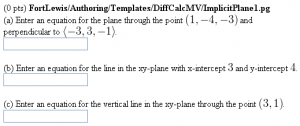ImplicitPlane1
Answer is an Equation for a Line or Plane
This PG code shows how to define an answer that is a line or plane.
- File location in OPL: FortLewis/Authoring/Templates/DiffCalcMV/ImplicitPlane1.pg
- PGML location in OPL: FortLewis/Authoring/Templates/DiffCalcMV/ImplicitPlane1_PGML.pg
| PG problem file | Explanation |
|---|---|
|
Problem tagging: |
|
DOCUMENT(); loadMacros( "PGstandard.pl", "MathObjects.pl", "parserImplicitPlane.pl", "parserVectorUtils.pl", "AnswerFormatHelp.pl", ); TEXT(beginproblem()); |
Initialization: |
Context("ImplicitPlane");
$A = non_zero_point3D(-5,5,1);
$N = non_zero_vector3D(-5,5,1);
$answer1 = ImplicitPlane($A,$N);
Context()->variables->are(x=>"Real",y=>"Real");
$answer2 = ImplicitPlane("4x+3y=12");
$answer3 = ImplicitPlane("x=3");
|
Setup:
The first answer is a standard mulitivariable calculus question. There are several different ways to specify the input to
When the |
Context()->texStrings;
BEGIN_TEXT
(a) Enter an equation for the plane through
the point \( $A \) and perpendicular to
\( $N \).
$BR
\{ ans_rule(20) \}
\{ AnswerFormatHelp("equations") \}
$BR
$BR
(b) Enter an equation for the line in the
xy-plane with x-intercept \( 3 \) and
y-intercept \( 4 \).
$BR
\{ ans_rule(20) \}
\{ AnswerFormatHelp("equations") \}
$BR
$BR
(c) Enter an equation for the vertical line
in the xy-plane through the point \( (3,1) \).
$BR
\{ ans_rule(20) \}
\{ AnswerFormatHelp("equations") \}
END_TEXT
Context()->normalStrings;
|
Main Text: |
$showPartialCorrectAnswers = 1; ANS( $answer1->cmp() ); ANS( $answer2->cmp() ); ANS( $answer3->cmp() ); |
Answer Evaluation: |
Context()->texStrings;
BEGIN_SOLUTION
Solution explanation goes here.
END_SOLUTION
Context()->normalStrings;
COMMENT('MathObject version.');
ENDDOCUMENT();
|
Solution: |
